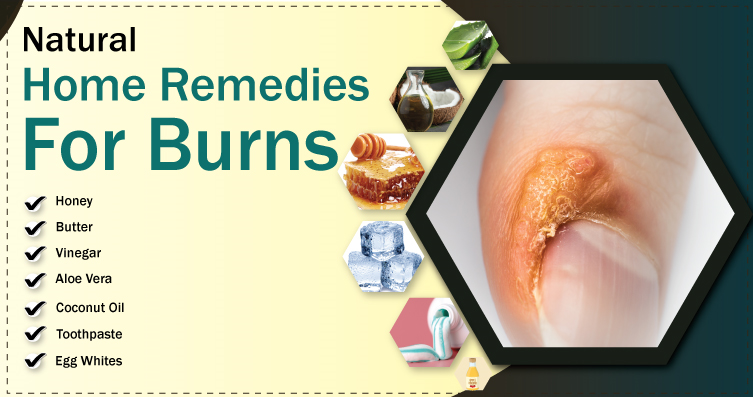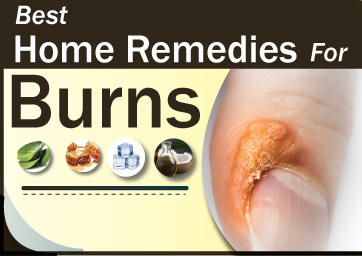Types of Burns
Before learning about home remedies for burns, let us look at the types of burns.
There are three layers to the skin:
Epidermis is the top layer of the skin.
Dermis is the second layer of the skin, located underneath the epidermis.
Hypodermis is the skin's deepest and most inner layer.
Burns are categorized into first, second, third, and fourth-degree depending on the impact it has on the three layers of the skin.
First-Degree Burn: Only the epidermis, or top layer of skin, is partially injured. The skin becomes irritated, reddish, and hot (in comparison to the surrounding tissue).
Second-Degree Burn: It reaches the dermis and causes blisters. It is characterized by discomfort and redness similar to the first degree but apparently more intense.
Third-Degree Burn: A third-degree burn, also known as a full-thickness burn, destroys the epidermis (outer layer of skin) as well as the entire layer underlying the dermis. The pain receptors are damaged during the burn, and there is no pain in the location of the third-degree burn. However, pain may be felt in nearby tissues (which are likely to have first and/or second-degree burns).
Fourth-Degree Burn: Also known as black burns (because of the color of the burn), Fourth-degree burns have a high mortality rate, and even if you survive, you'll need considerable medical treatment, such as skin grafts. Significant fires or electrical shocks are common causes of fourth-degree burns.
When Can You Treat a Burn at Home?
If the skin is still intact, first- and second-degree burn relief is very simple. Remove the tissue from the source of the injury. Treat the pain and keep an eye on the skin to make sure it doesn't become infected.
Seek immediate help from your doctor, hospital, or burn center if the skin is damaged, extends over a greater area, or is deeper than a second-degree burn.
Applying Home Remedies for Burns
When it comes to burning relief, even the most basic procedures must be performed correctly. If you're wondering how to heal a burn fast, the answer is to follow the appropriate procedure, which begins with basic first aid.
For speedy and safe burn relief, keep the following burn remedies in mind and follow them strictly:
Step 1: Clean the Burn
The basic first aid after any minor burn is to run cool water over the burn area for 15 to 20 minutes and then wash the affected area with light soap and water.
Instead of scraping, use delicate strokes to gently clean the wound. Cleaning the burn gently will prevent it from becoming infected and infecting the wound further.
Step 2: Apply Bandage
A person may not need to wrap tiny first or second-degree burns with a bandage if the burn blisters are not open. In a wet, covered setting, however, burns heal faster.
Remove all clothing from the burning area. Remove any jewelry that may come into contact with the burn area. Apply a damp, sterile bandage to the burn that has been soaked in room temperature water or saline. The bandage should be kept cool and moist to promote faster burn relief. Wrap the burned skin lightly to avoid putting pressure on it. By keeping air out of the area, bandaging reduces agony and protects blistered skin.
Step 3: Apply Antibiotic Creams
When a burn has open blisters, antibiotic lotions and ointments may be used. Antibiotic creams can help prevent infection and speed up burn relief. Cover any exposed blisters after using an antibiotic lotion to protect the wound from infection.
Step 4: Use Pain Relief Medicine
The discomfort of first- and second-degree burns last until they heal. A person may choose to take drugs to help with pain and inflammation. Any remaining burn discomfort can be relieved with over-the-counter anti-inflammatory medications such as acetaminophen and ibuprofen.
Step 5: Stay Out of The Sun
Protect the burn site from direct sunlight and hot temperatures. If you can't help but go out for work or other pressing issues, the wound should be covered with loose-fitting clothing.
Best Natural Home Remedies for Burns
If you are aware of natural burn remedies, then healing mild burns should not be a cause of concern for you. So, instead of squandering valuable time rushing toward a nearby medical facility, try the mild burn remedies listed below.
These home remedies for a burn will not only aid in the prevention of infection but will also aid in immediate burn relief.

1. Honey
If you have a mild to severe superficial burn, there is enough data to suggest that honey can be used to treat it. Honey acts as a disinfectant in burns and aids in speedier healing due to its antibacterial qualities.
2. Vinegar
Diluted vinegar contains acetic acid, which helps to relieve pain, inflammation, and discomfort associated with a burn. Applying vinegar to damaged skin can be incredibly therapeutic since it keeps the burn infection-free.
Read Also: 6 Proven Benefits Of Apple Cider Vinegar
3. Aloe Vera
Applying fresh Aloe Vera gel to a wound can help it recover faster. Aloe vera can also be used to treat first-degree burns. Because of its antibacterial and anti-inflammatory properties, aloe vera is an excellent healer.
Remedies to Stay Away From
1. Butter
Butter has little to no evidence of being effective as a burn treatment. In addition, it's probable that it'll make your burn worse.
2. Coconut Oil
Contrary to popular belief, coconut oil does not cure everything. Applying it may irritate and infect the skin even more.
Read Also: Health Benefits Of Coconut Oil
3. Egg Whites
Applying egg white to burns is not recommended due to the dangerous risk of salmonella infection
4. Toothpaste
Putting toothpaste on a burn is never a smart idea. This is yet another urban legend with no supporting evidence. Toothpaste may aggravate the burn, making infection spread more easily.
5. Ice
On a burn, avoid using ice or even ice-cold water. The application of extreme cold to a burn might cause severe tissue damage. Ice and really cold water will aggravate your burn.
Burn Scar and Recovery
Burns of the first degree should heal without scarring in about a week.
Second-degree burns are expected to heal in two weeks. They might leave a scar, although it normally fades over time.
Third-degree burns can take months or even years to recover. They leave scars behind them. A skin graft may be required to remove these scars.
Before We Wrap Up:
Mild Burn Relief: The Do’s
As quickly as possible, turn on a tap or shower with cold running water (at least for 10 minutes; preferably for 20 minutes duration).
For chemical burns, first, flush the chemical off the skin using isopropyl (rubbing) alcohol, then flush with water. Remove any infected clothing or jewelry. Chemical contamination should be avoided at all costs. Using a clean bandage, cover the burn. Visit a doctor immediately.
Mild Burn Relief: The Don'ts:
When Not to Ignore A Burn
Get professional medical help:
if the person has been severely injured,
if the burn is causing significant pain,
if the burn affects sensitive areas like the eyes
or if the burn covers a significant area of the body
Find the best emergency burn relief from the best health experts near you. Visit Kayawell for emergency medical care anywhere anytime.



 Contact Us
Contact Us







 Hospitals
Hospitals
 Doctors
Doctors
 Diagnostic
Diagnostic
 Pharmacy
Pharmacy
 Health Tips
Health Tips
 Blog
Blog


















Comments